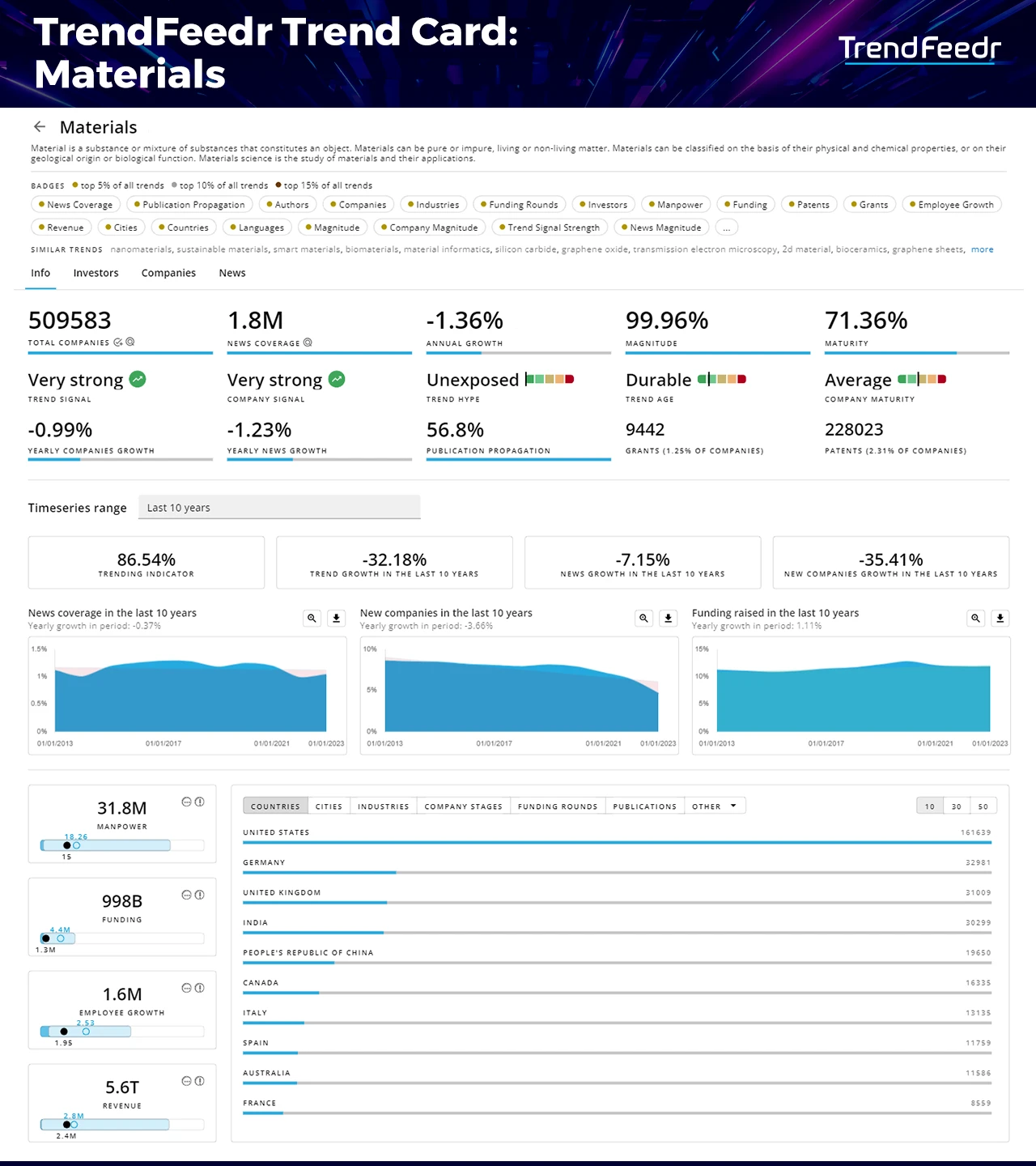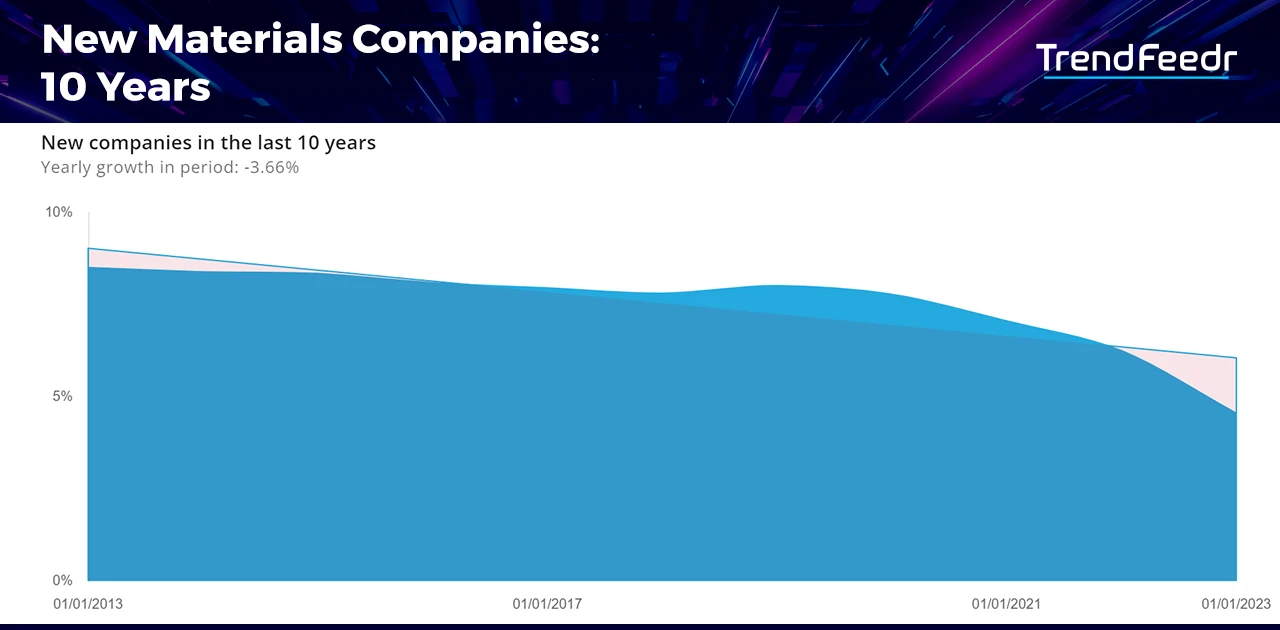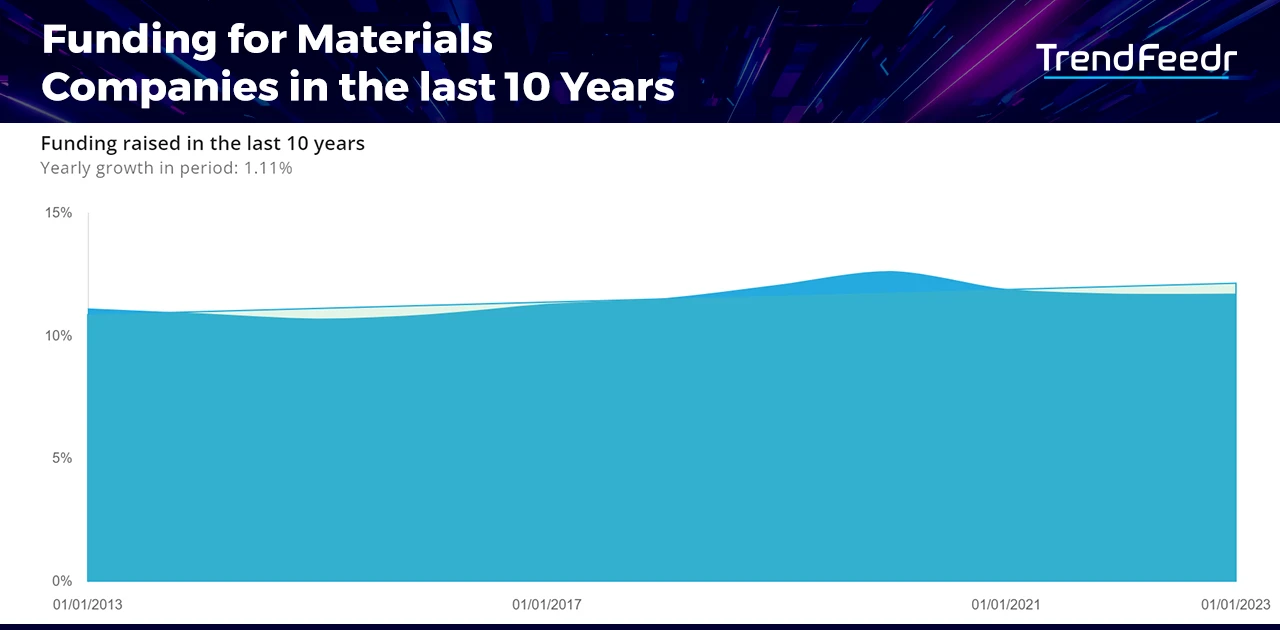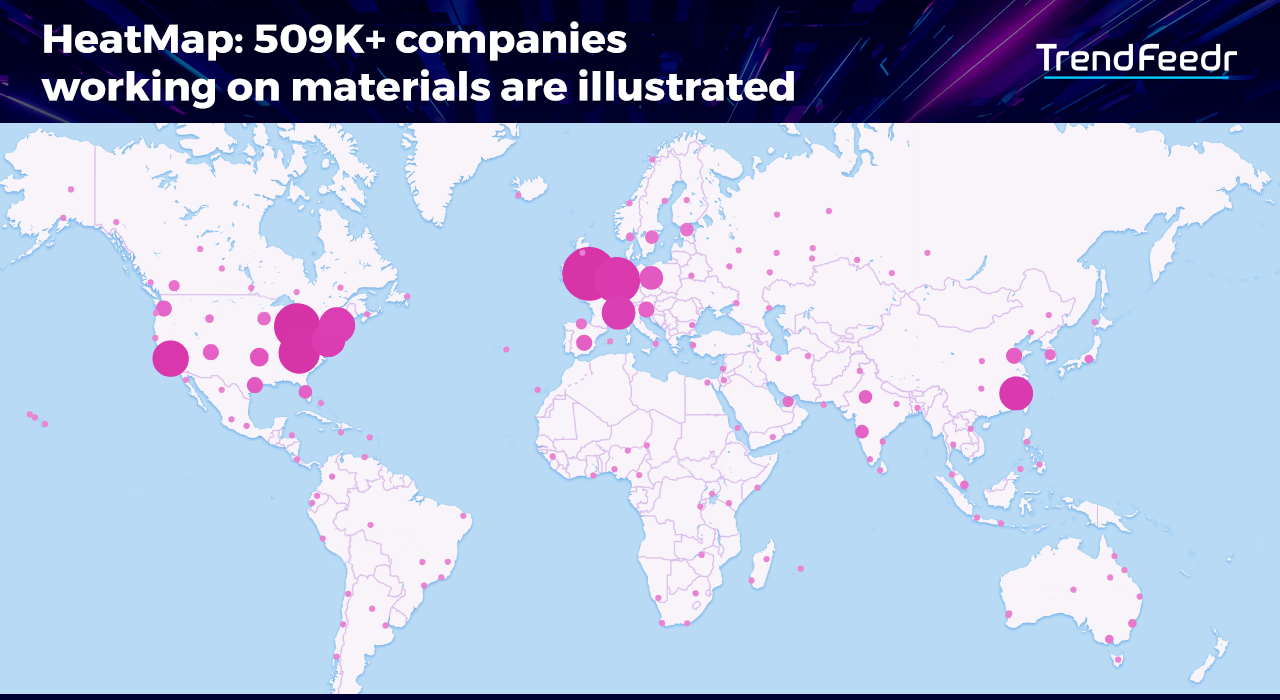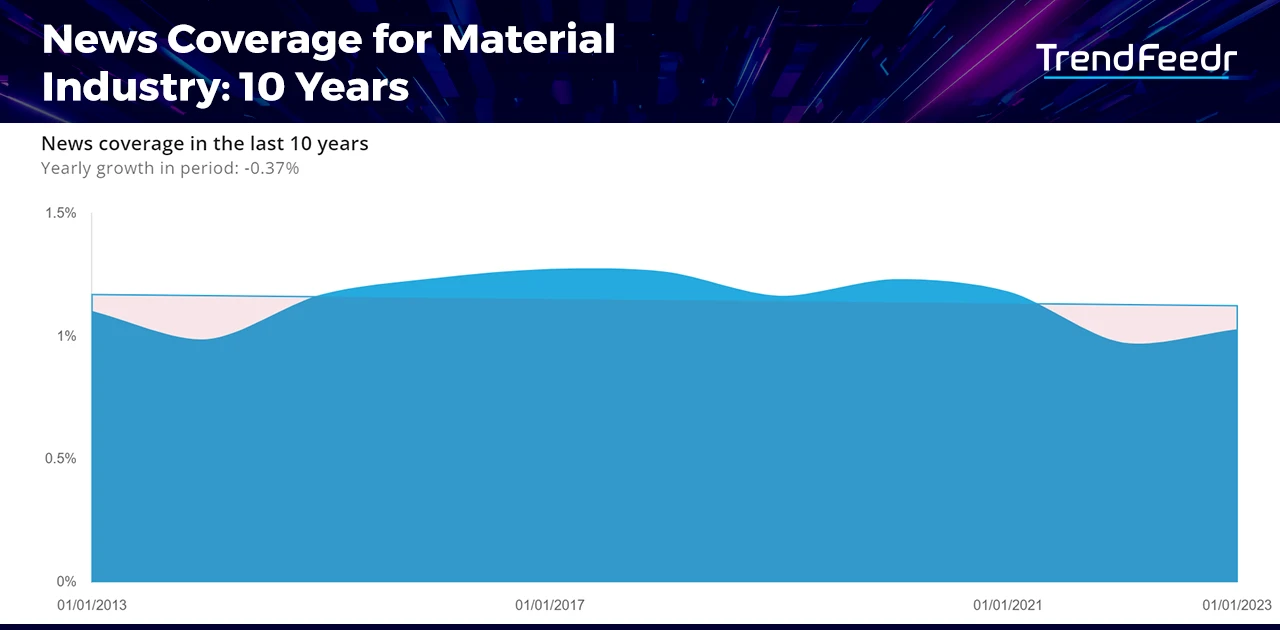As innovative breakthroughs are reshaping industries, the materials sector is leading the charge in technological advancement. This material trends report explores the dynamic shifts within the realm of materials science that revolutionize manufacturing and product design. They are redefining sustainability, efficiency, and the future of design.
Pioneering materials, such as self-healing polymers and graphene, are providing answers to some of today’s most pressing challenges. Take the aerospace industry, for instance, where the integration of advanced composites is transforming aircraft design. It reduces aircraft weight and also improves performance and fuel efficiency. In the electronics sector, the emergence of conductive inks is ushering in a new age of flexible, wearable technology. Similarly, the medical field is experiencing significant shifts with the introduction of biocompatible materials that pave the way for advances in prosthetics and implantable devices.
This transition marks a critical change in the function of materials – evolving from mere components of products to essential contributors to performance and innovation. The economic impact of this transition is significant. An IndustryARC report projects an impressive growth path for the advanced materials market, estimating it will reach US$2.1 trillion by 2025, with a CAGR of 4.5% from 2020 to 2025. This reflects the escalating importance and demand for advanced materials across industries.
In this data-driven material trends report, we look into current material trends, putting a spotlight on nanomaterials, sustainable materials, smart materials, bio-based materials, and material informatics.
Key Takeaways
- Dominant Trend: The material industry is witnessing remarkable growth and maturation, with a trend magnitude of 99.96% and a trend maturity of 71.36%, according to TrendFeedr.
- Technological Convergence: Companies in the materials sector are embracing emerging trends such as nanomaterials, sustainable materials, smart materials, bio-based materials, and material informatics, reflecting the industry’s innovative response to global challenges.
- Media Coverage: There’s a slight decrease of 0.37% in annual news coverage over the past decade, suggesting a shift in focus towards other emerging tech sectors from material trends.
- Investment Landscape: The materials industry boasts approximately 509K+ active entities, collectively drawing an investment capital of nearly US$998 billion.
- Prominent Investors such as Tiger Global Management, SoftBank Vision Fund, and Warburg Pincus are injecting substantial funds into groundbreaking material ventures.
- Global Centers: The United States, Germany, the United Kingdom, India, and China are at the forefront of materials initiatives, with cities like New York City, London, Mumbai, Sydney, and Singapore emerging as innovation hotspots.
Table of Contents
- Understanding Material Trends
- Material Trend Card
- Emerging Trends & Technologies Disrupting Material
- 5 Key Material Trends
- 5 Emerging Material Companies
- Material Investment Trends
- Mapping Global Material Companies
- Media Coverage of Material
- Future of Material
For this detailed analysis of material trends, we use TrendFeedr, our all-in-one trend intelligence platform. TrendFeedr uses advanced algorithms to identify future industry and tech trends. With a focus on trend discovery, clustering, and analysis, the AI-powered platform reviews thousands of trends each week to provide actionable insights.
Among more than 20,000 trends and technologies monitored by TrendFeedr, the material sector has made a notable impact. Here’s why:
- The material industry holds a position in the top 10 trends, marking its place in the top 1% of global trends. This underlines its pivotal role in fostering innovation across various industries, from aerospace to medical technology.
- With a trend maturity of 71.36%, the material sector is a well-established field with potential for further innovation and market growth. This maturity level signifies a sector teeming with opportunities for both established firms and startups.
- The spotlight in the material sector is increasingly on sustainable and smart materials. These domains are drawing substantial investments and are anticipated to spearhead future technological breakthroughs.
This material trends report explores various aspects including performance, investment, regional, and future outlook.
Understanding Material Trends
The material industry is undergoing a significant transformation, driven by evolving demands and innovative applications.
What are material industry trends?
Key trends in the materials sector encompass a shift towards sustainability, with materials engineered for recyclability and minimal environmental footprint. Another trend is lightweighting, where industries are in pursuit of lighter yet robust materials for improved efficiency and performance. This trend is particularly noticeable in the automotive and aerospace sectors. Further, smart materials alter their properties in response to external stimuli such as stress, temperature, moisture, pH, and electric or magnetic fields.
The trend towards biodegradability and the utilization of bio-based materials is also gaining traction. Companies are reducing their carbon footprint and catering to consumer demand for eco-friendly products with bio-based materials. These materials present a viable solution to the ubiquitous issue of waste, especially in the packaging industry.
What are emerging technologies in materials?
Nanotechnology lies at the core of many material trends. It is instrumental in the development of materials with enhanced properties, such as increased strength, lighter weight, improved control of light spectrum, and higher chemical reactivity. Computational materials science, another enabling technology, employs powerful simulations to predict the behavior and interaction of materials. This expedites the discovery and development of new materials.
Further, biotechnology is reshaping the materials landscape by facilitating the development of living materials that grow, self-repair, and adapt to their environment. It is revolutionizing sectors from healthcare to construction. Innovative synthesis and processing techniques, such as 3D printing and advanced molding, are also simplifying the creation of complex material geometries and designs that were previously unattainable. It is paving the way for customized and high-performance materials.
Material Trend Card: A Global Overview of the Dynamic Material Landscape
The Material Trend Card provides a snapshot of the material industry that is fundamental to innovation and manufacturing across the globe. Here’s what the data tells us:
Looking for all trends related to materials?
- Sector Maturity: The material industry, with a trend maturity of 71.36%, is both established and dynamic. It’s classified as ‘Durable’ in the trend age, underscoring its fundamental role in supporting various industries, from construction to high-tech.
- Industry Overview: With 509,583 total companies, the materials sector is vast, showing a slight annual contraction in new companies growth by -0.99%.
- Media Engagement: The industry has seen considerable media coverage with 1.8 million news stories and a modest annual decline in news coverage (-1.23%).
- Innovation Pulse: The sector is proactive in innovation, boasting 228,203 patents, indicative of a thriving environment for research and development.
- Financial Health: Despite a 35.41% decline in the number of new companies founded over the past decade, the funding raised during the same period saw a rise of 7.15%, suggesting investor confidence in the lasting value of materials.
- Employment and Growth: The industry employs a significant workforce of 31.8 million, with an annual employee growth of 1.6 million.
- Economic Impact: Generating a massive US$5.6 trillion in revenue, the materials sector is a major player in the global economy.
- Geographical Hotspots: The United States and Germany are leading players, with the United Kingdom and India also making their mark in the industry landscape.
- Market Dynamics: The sector is characterized by a ‘Very Strong’ trend signal and company signal. However, it’s labeled as ‘Unexposed’ in trend type with a 56.8% publication propagation, hinting at potential developments that may not be fully captured by mainstream media.
Stay with us as we delve deeper into these compelling statistics of the material industry. These insights reveal how its evolving landscape is shaping the innovations and infrastructure of tomorrow.
How do Emerging Trends Disrupt the Material Industry?
The material industry is currently undergoing a significant transformation, propelled by innovative trends that are setting new benchmarks for innovation and sustainability.
Nanomaterials
Representing a frontier in materials science, nanomaterials focus on manipulating matter at the nano-scale to achieve exceptional properties. These materials have various applications including solar hydrogen, thermoelectric devices, biomedical imaging, and cancer therapy.
Companies like LAM-X are leading the way in harnessing the potential of nanomaterials. The company’s antimicrobial nanofiber technology utilizes a dense network of nanofibers to block pathogens and activate upon light exposure for sterilization. This innovation prevents healthcare-associated infections and enhances the lives of patients.
Sustainable Materials
Green materials are transforming the industry by providing eco-friendly alternatives to traditional materials. These materials include bamboo, wood, hemp, bio-plastics, recycled cotton, and organic linen, which are used for their renewable, recyclable, and low environmental impact properties.
Initiatives like Pack 2 Earth’s development of home compostable packaging materials advances the circular economy. The startup produces packaging films for pouches and doy packs and injection materials for caps, valves, and fitments. Made from plant matter, these materials decompose into toxin-free compost.
Smart Materials
Known for their ability to respond to changes in their environment, smart materials are another emerging trend. They lead to innovations in various applications, from energy efficiency to improved product lifespans.
Auxilium, for example, develops wound dressing technology that conforms to the wound and senses physiological markers to indicate infection. The smart material prevents biofilm formation, accelerates healing, and reduces the time and cost spent on medical intervention.
Bio-based Materials
Bio-based materials are composed of matter derived from living organisms. These materials include wood, leather, silk, wool, cellulose, and more. Leveraging bio-based materials reduces dependency on fossil resources, and offers properties like biodegradability and lower toxicity.
Covation Biomaterials exemplifies this trend by manufacturing bio-based products for diverse uses such as sustainable textiles and biodegradable materials for personal care. It replaces petroleum-based products with high-performance bio-based alternatives.
Materials Informatics
Material informatics is revolutionizing the way materials research and development is conducted. By integrating AI and data analytics, researchers and companies predict material properties, optimize material selection, and accelerate the discovery of new materials.
Polymerize’s material informatics platform is a prime example of this trend in action. Its machine-learning platform aids chemical companies in managing data, finding optimal formulations, and making data-driven decisions. The startup thus accelerates the material development process and reduces costs.
These emerging trends are paving the way for a future where materials are smarter, more sustainable, and more responsive to the needs of both the planet and its inhabitants.
5 Key Material Trends & Firmographic Insights
In terms of human resources, the material industry employs a total of 31.8 million professionals. The average team size of emerging material companies stands at 93, indicating the presence of industry behemoths with extensive workforces, nimble startups, and SMEs. A median of 15 suggests that more than half of these organizations favor a leaner structure, possibly to adapt to the industry’s dynamic landscape.
Employee growth figures are equally revealing. With an annual increase of 1.6 million professionals, the materials sector is flourishing. The average annual employee growth per company is 6, with a median of 1.95, suggesting prudent yet consistent expansion strategies across the spectrum.
Let’s explore the market dynamics of five specific trends that are revolutionizing the material industry. These trends include the focus on nanomaterials, the shift towards sustainable materials, advances in smart materials, the progression of bio-based materials, and the emergence of material informatics. For each trend, we will delve into the complex dynamics of market growth, encompassing the number of professionals engaged, the magnitude of investment, and the number of organizations involved. This analysis will offer insights into how these trends are driving the transformation of the material landscape.
1. Nanomaterials
- From diagnostics to drug delivery and energy storage to environmental remediation, nanomaterials are revolutionizing a wide range of industries with their diverse and novel properties.
- A total of 5,754 organizations have collectively secured US$30.5 billion in funding.
- Further, a workforce of 190.1K is propelling the nanomaterials trend, underscoring the substantial human capital invested in exploring the potential of nanotechnology.
2. Sustainable Materials
- Green materials embody the industry’s dedication to minimizing environmental impact through the development of renewable and less environmentally damaging materials.
- This trend is being spearheaded by 3,165 organizations, with a cumulative funding of US$7.9 billion.
- The 165.8K individuals working in this domain are leading the charge in creating materials that offer sustainability without sacrificing quality or functionality.
3. Bio-based Materials
- These materials, like wood, cellulose, and hemp fiber, have applications in building and healthcare products to food preservation and waste treatment.
- Bio-based materials have attracted 2,179 organizations, with funding amounting to US$14.8 billion.
- Further, it employs 91.3K professionals who are engaged in research and development of materials to transform medical treatments and diagnostics.
4. Smart Materials
- By dynamically responding to environmental changes such as temperature, force, stress, and pressure, smart materials show potential across automotive manufacturing, structural health monitoring, energy harvesting, etc.
- A total of 404 organizations are working on this trend with funding amounting to US$997.2 million.
- It employs a workforce of 19.5K who are developing responsive materials for a broad spectrum of applications.
5. Materials Informatics
- Materials Informatics is utilized for discovering new materials, optimizing existing ones, and identifying formulations that balance performance, cost, and sustainability.
- This emerging trend encompasses 37 organizations that have garnered US$258.7 million in funding.
- It employs a total of 1,564 individuals who are paving the way for a revolution in the discovery, analysis, and commercialization of materials by harnessing the power of big data and machine learning.
These trends underscore the spirit of innovation within the material industry as it endeavors to cater to the needs of the contemporary world with smarter, more sustainable, and more efficient materials.
Emerging Material Companies Leading The Way
Despite a marginal yearly decrease of 3.66% in the emergence of new organizations over the past ten years, this trend represents a sign of a maturing market where most resilient and innovative companies continue to prosper. The COVID-19 pandemic had a significant impact on global supply chains and economic conditions. This could have contributed to a decrease in new business formation in various sectors, including materials.
5 Promising Material Startups
Material startups are at the forefront of advancements in industrial and consumer products, championing the development of new materials with superior properties and environmentally friendly attributes. From biodegradable composites to smart materials that alter properties on demand, these startups are addressing key challenges in sustainability, performance, and cost-effectiveness. Here’s a snapshot of five emerging materials startups established in the last five years:
- Syenta specializes in the 3D printing of multi-material electronics, offering material versatility for fabrication and prototyping.
- MYCEL is at the forefront of biomanufacturing, reflecting, recollecting, and circulating through biomimicry by harnessing the physiological, biochemical, and physical traits of fungi & mushrooms.
- TruSpin develops an alternating current electrospinning production platform for the mass production of nanofibers.
- Pearl Bio’s technology combines genome and ribosome engineering to produce novel biologics with diverse chemistries.
- A2O Advanced Materials manufactures materials that utilize dynamic bonding to create products that are more durable and resilient. These materials self-heal, respond to their environment and regenerate adhesive properties over time.
Material Industry Investment Trends
In terms of financial support, the total funding of the material sector ranks in the top 5% of all 20K+ trends and technologies covered by TrendFeedr.
The time series chart showcases a slight yearly increase of 1.11% in funding raised over the past ten years. This hints at a market that is becoming increasingly discerning and strategic in its investments.
A Closer Look at the Financials
As per TrendFeedr, the total funding involved in the material industry amounts to a remarkable US$998 billion. The pinnacle of funding is marked by Tronox with a single maximum contribution of US$1.8 billion. On average, companies have garnered US$27.5 million in funding, while the median funding amount is at US$1.3 million.
TrendFeedr estimates that the total revenue across the materials industry stands at a staggering US$5.6 trillion. The highest revenue reported by a single company, Daher, is US$1.8 billion. The average company revenue is estimated at US$16.1 million and the median at US$2.4 million.
7.15% of material companies have received funding. The types of funding these companies are securing range from seed capital to jumpstart their innovative ventures to early-stage venture capital or Series A funding to elevate their business. Grants, totaling 9442 received, benefit a modest 1.25% of material companies, reflecting targeted support for specific projects. Venture rounds and debt financing also play a significant role in bolstering the continuous growth and scaling of companies within this sector.
Prominent Investors in the Material Industry
Tiger Global Management, a significant player in the investment arena, has an investment sum of US$3.6 billion distributed across a portfolio of 51 diverse companies. Its most substantial funding initiatives include a significant US$308.3 million to OFB and US$235 million to Infra.Market.
Close on their heels, SoftBank Vision Fund has infused a considerable US$3.1 billion into 22 companies. Its major investments include US$328.5 million for Flock Freight and US$150 million for Formlabs.
Warburg Pincus, another influential entity in the investment community, has allocated US$1.6 billion across 26 companies. The allocation includes a noteworthy US$290.7 million to Insilico and US$190.4 million to Constructionline.
Public sector investments are also significant, with a remarkable US$39.7 billion directed into 1086 companies. This suggests that public funds are equally assertive in fostering growth and innovation within this sector. Major investments include US$294 million into Hexcel and US$291.4 million into Changshu Fengfan Electric Power.
The diversity of backers in material trends is noteworthy too, with unique investors ranking in the top 5% of all trends.
Geographical Activity of Material Companies
The following heatmap offers a comprehensive snapshot of the current trends in the material industry, highlighting the participation of approximately 509K+ companies.
Interested to explore all 509K+ material companies?
The United States leads the pack as a hub for material innovation and commercialization. Germany, with its precision engineering tradition and robust manufacturing base, is a close second in the material sector. The United Kingdom, known for its emphasis on research, holds a distinguished position in the global arena. India is emerging as a significant player with its rapidly growing industrial sector and focus on sustainable materials. Lastly, China is a powerhouse with its vast industrial capacity and strategic investments in new materials research.
In the urban landscape of material innovation, certain cities have made noteworthy contributions to the field. New York City serves as a fertile ground for material companies, particularly those applying advanced materials in the tech and construction sectors. London has seen a surge in material startups and research initiatives. Mumbai is also experiencing a significant rise in material companies, spurred by the city’s focus on infrastructure and technological development. Sydney’s emphasis on research, especially within universities and public institutions, is fostering the growth of material companies in the region. Lastly, Singapore, with its strategic geographic location and government support for innovation, is cultivating a thriving ecosystem for the growth of the material industry.
Media Coverage for the Material Industry Sees a Yearly Decline of 0.37% Over the Last 10 Years
While the media landscape for the material industry is constantly evolving, there has been a slight yearly decrease of 0.37% in growth over the past ten years. This suggests that while material trends continue to be a subject of substantial interest, there might be a saturation in the number of new stories or a shift in focus towards other emerging tech sectors.
It’s worth noting that the publication coverage of the material industry ranks in the top 5% of all trends. From 2005 to 2023, the number of articles written was 1,725,583, placing material trends in the top 5% of all emerging trends.
What is the Future of the Material Industry?
The material industry is influenced by a multitude of factors including technological advances, environmental considerations, and shifting market demands. Here’s the material outlook:
1. Technological Integration
The integration of advanced computational techniques, such as AI-powered predictive models, quantum computing, and high-throughput simulations, is revolutionizing the material industry. Along with accelerating the development of advanced materials, it is also catalyzing innovation through rapid prototyping, enhancing materials characterization, and facilitating complex materials systems design.
2. Customization
There’s a growing focus on customization in the material industry. This shift is driven by the need to address intricate engineering problems and cater to specific application requirements. The industry is increasingly prioritizing the development of materials with bespoke shapes, sizes, and functional properties. This trend is enhancing the versatility of materials and also opening up new avenues for innovation and application.
3. Revolution in Recycling
The rise of cutting-edge recycling technologies enhances the recovery of materials at their end of life. This contributes to waste minimization and also promotes resource conservation by reintegrating recycled materials into the production cycle. Importantly, it reduces the need for virgin materials, thereby promoting a more sustainable and efficient use of resources.
4. Expansion of Specialty Markets
The demand for specialty materials, specifically designed for extreme conditions or unique applications like space exploration, is projected to surge. It is driven by the ability to engineer materials with highly specialized properties.
5. Bridging the Lab-to-Market Gap
The transition from laboratory development to commercial application of materials is anticipated to become more seamless. This is due to improved technology transfer practices and synergies between academia, research institutions, and industry stakeholders. This will fast-track the introduction of state-of-the-art materials into the market.
Material Trends: Navigating New Frontiers in Material Science
As we wrap up our journey through the material trends report, it is clear that we are moving through a rapidly changing landscape. The pace of discoveries is fast, and the range of possibilities seems endless. Keeping up with these changing trends is very important. It allows you to anticipate changes, take advantage of new opportunities, and stay ahead in a field that is shaping the future of technology. But how do you do that?
Connect with material enthusiasts, industry leaders, and innovative creators; their insights can provide valuable perspectives and open up opportunities for collaboration. Dive into material market research reports, attend material-focused seminars and conferences, and participate in online material communities. Also, leverage trend-tracking tools, like TrendFeedr, that meticulously track up to 1291 sub-trends, offering a comprehensive view of the evolving material landscape.


